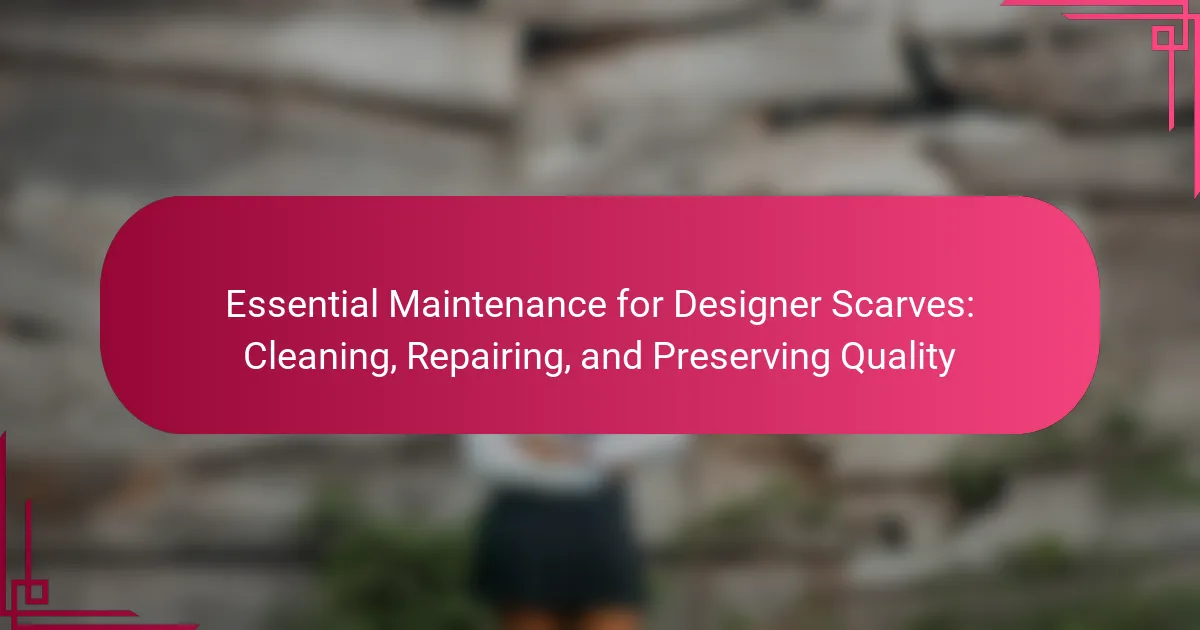Designer scarves require essential maintenance to ensure their longevity and appearance. Key practices include proper cleaning, careful storage, and timely repairs. Regular cleaning, often through hand washing or dry cleaning, prevents dirt buildup and maintains fabric quality. Scarves should be stored in a cool, dry place, folded or rolled to avoid creasing. If damage occurs, prompt repairs using hand stitching or professional services can restore the scarf’s integrity. Following these guidelines helps preserve the quality of designer scarves over time.

What is Essential Maintenance for Designer Scarves?
Essential maintenance for designer scarves includes proper cleaning, careful storage, and timely repairs. Regular cleaning prevents dirt accumulation and maintains fabric quality. Dry cleaning is often recommended for delicate materials like silk or cashmere. Storing scarves in a cool, dry place protects them from moisture and sunlight. Folding or rolling scarves prevents creasing and damage. If a scarf gets damaged, prompt repairs can extend its life. Using a professional service for repairs ensures quality restoration. Following these practices preserves the scarf’s appearance and longevity.
Why is maintenance important for designer scarves?
Maintenance is important for designer scarves to preserve their quality and longevity. Regular maintenance prevents fabric deterioration and color fading. Proper cleaning methods can remove dirt and oils without damaging delicate materials. Repairing minor damages, like loose threads or small tears, can prevent more significant issues. Storing scarves correctly helps maintain their shape and prevents creasing. Designer scarves often represent a significant investment, making maintenance essential for retaining value. According to fashion experts, well-maintained scarves can last for decades, enhancing their worth over time.
What are the common issues faced by designer scarves without proper maintenance?
Designer scarves can face several common issues without proper maintenance. These issues include fading of colors due to exposure to sunlight. Dirt and stains can accumulate, leading to permanent discoloration. Fabric can become frayed or damaged from improper washing techniques. Additionally, improper storage can result in creases and wrinkles that are difficult to remove. Without care, the material may lose its softness and luster over time. Regular maintenance is essential to preserve the quality and appearance of designer scarves.
How does maintenance affect the longevity of designer scarves?
Proper maintenance significantly enhances the longevity of designer scarves. Regular cleaning prevents dirt and oils from degrading the fabric. Gentle washing methods, such as hand washing or using a delicate cycle, preserve the material’s integrity. Storing scarves properly also protects them from damage. Folding instead of hanging prevents stretching and maintains shape. Additionally, repairing small damages promptly prevents further deterioration. Using appropriate storage bags can shield scarves from dust and sunlight. Overall, consistent and careful maintenance prolongs the life of designer scarves.
What are the key components of maintaining designer scarves?
The key components of maintaining designer scarves include proper cleaning, careful storage, and timely repairs. Cleaning should be done according to the fabric type, with many designer scarves requiring dry cleaning to preserve their quality. Storage should involve keeping scarves in a cool, dry place, ideally folded or rolled to avoid creasing. Timely repairs, such as mending loose threads or small tears, help extend the life of the scarf. Regular inspection for wear and tear is also essential. Using protective measures, like storing scarves in breathable bags, can prevent damage from dust or pests. Following these practices ensures the longevity and aesthetic appeal of designer scarves.
What cleaning methods are recommended for designer scarves?
Hand washing is the most recommended cleaning method for designer scarves. Use cold water and a mild detergent. Gently agitate the water to create suds. Submerge the scarf and lightly rub the fabric. Avoid wringing or twisting the scarf to prevent damage. Rinse thoroughly with cold water until all detergent is removed. Lay the scarf flat on a clean towel to dry. Avoid direct sunlight and heat sources during drying. Dry cleaning is also a safe option for delicate fabrics. Always check the care label for specific cleaning instructions.
How can repairs be effectively executed on designer scarves?
Repairs on designer scarves can be effectively executed by following specific techniques. First, assess the damage to determine the appropriate repair method. For small holes or tears, use a needle and thread that matches the scarf’s fabric. Hand-stitching is often recommended for delicate materials to avoid further damage. For frayed edges, consider using fabric glue or a heat seal to prevent further unraveling. If the scarf has a stain, spot-clean it with a gentle fabric cleaner suitable for the material. For more extensive damage, consulting a professional tailor or dry cleaner specializing in high-end fabrics is advisable. These professionals can provide expert repairs and maintain the scarf’s integrity. Proper care and timely repairs can extend the life of designer scarves significantly.
What practices help in preserving the quality of designer scarves?
To preserve the quality of designer scarves, proper care practices are essential. Hand washing in cold water with mild detergent protects delicate fabrics. Avoiding harsh chemicals prevents damage to the material. Air drying flat maintains the scarf’s shape and prevents stretching. Storing scarves in a cool, dry place avoids moisture and mildew. Using acid-free tissue paper when folding helps prevent creases. Keeping scarves away from direct sunlight preserves color vibrancy. Regularly inspecting for loose threads allows for timely repairs. Following these practices ensures longevity and maintains the scarf’s luxurious appearance.
How can one prevent damage to designer scarves during storage?
To prevent damage to designer scarves during storage, use proper folding techniques. Fold scarves neatly to avoid creases and wrinkles. Store them in a cool, dry place to prevent moisture buildup. Avoid hanging scarves, as this can stretch the fabric. Use breathable fabric bags or acid-free tissue paper for protection. Keep scarves away from direct sunlight to prevent fading. Regularly check for any signs of damage or pests. Proper storage methods can significantly extend the life of designer scarves.
What are the best ways to display designer scarves without compromising quality?
The best ways to display designer scarves without compromising quality include using padded hangers and shadow boxes. Padded hangers prevent creasing and maintain the scarf’s shape. Shadow boxes protect scarves from dust and sunlight, preserving their colors. Displaying scarves flat on a dedicated shelf also minimizes wear. Avoid using metal hangers, as they can cause snagging. Regularly rotate displayed scarves to prevent fading. Ensure proper storage conditions, like low humidity, to maintain fabric integrity. These methods effectively preserve the quality of designer scarves.

How do you clean designer scarves properly?
To clean designer scarves properly, first check the care label for specific instructions. Hand washing is often recommended for delicate fabrics like silk or cashmere. Use cold water and a gentle detergent specifically designed for delicate items. Submerge the scarf and gently agitate the water without twisting or wringing it. Rinse thoroughly in cold water until all detergent is removed. Lay the scarf flat on a clean, dry towel to absorb excess water. Avoid hanging it to dry, as this can stretch the fabric. Instead, reshape the scarf while it is flat and allow it to air dry away from direct sunlight. Always ensure that the cleaning method aligns with the material of the scarf for best results.
What are the recommended cleaning techniques for different materials?
Silk scarves require gentle cleaning techniques. Hand washing in cold water with mild detergent is recommended. Avoid wringing or twisting the fabric. Lay flat to dry to maintain shape and prevent damage.
Wool scarves should be hand washed or dry cleaned. Use a wool-specific detergent to prevent shrinking. Rinse thoroughly and avoid agitation.
Cotton scarves can be machine washed on a gentle cycle. Use warm water and a mild detergent. Tumble dry on low heat or air dry to prevent wrinkles.
Synthetic scarves are often machine washable. Use cold water and a gentle cycle. Avoid fabric softeners to maintain the fabric’s integrity.
For leather scarves, spot cleaning with a damp cloth is advised. Use a leather conditioner afterward to maintain suppleness.
Each material has specific care requirements to ensure longevity and preserve quality. Proper techniques prevent damage and fading over time.
How does hand washing differ from machine washing for scarves?
Hand washing and machine washing differ significantly for scarves. Hand washing is a gentle method that minimizes fabric damage. It allows for better control over water temperature and agitation. This method is less likely to cause pilling or stretching of delicate materials. Machine washing, on the other hand, uses a more vigorous cycle. This can lead to wear and tear on the fabric. Additionally, machine washing may expose scarves to harsher detergents and higher temperatures. Hand washing is recommended for silk, wool, and other sensitive materials. Studies show that hand washing maintains the integrity of delicate fabrics better than machine washing.
What detergents are safe for cleaning designer scarves?
Mild detergents are safe for cleaning designer scarves. Look for pH-neutral or delicate fabric detergents. Brands like Woolite and The Laundress are recommended. These detergents do not contain harsh chemicals. They help maintain the fabric’s integrity and color. Always check the care label before washing. Testing on a small area is advisable. This approach prevents damage to the scarf.
What precautions should be taken while cleaning?
Precautions while cleaning designer scarves include checking care labels for specific instructions. Use gentle detergents suitable for delicate fabrics. Test cleaning solutions on a small, inconspicuous area first. Avoid hot water, as it can damage fibers. Do not wring or twist the scarf; instead, gently blot excess water. Air dry the scarf away from direct sunlight to prevent fading. Store the scarf properly after cleaning to maintain its shape and quality. Following these precautions helps preserve the scarf’s integrity and longevity.
How can you test for colorfastness before cleaning?
To test for colorfastness before cleaning, use a simple method involving water and a cotton swab. Dampen the cotton swab with water. Gently rub the swab on an inconspicuous area of the fabric. Observe if any color transfers to the swab. If color transfers, the fabric is not colorfast. This method is effective for identifying potential bleeding during cleaning. Testing in a hidden area preserves the overall appearance if issues arise.
What should you avoid when cleaning designer scarves?
Avoid using harsh chemicals when cleaning designer scarves. These chemicals can damage delicate fabrics and colors. Do not machine wash designer scarves, as agitation can cause fraying or loss of shape. Avoid using hot water, which can shrink or distort the material. Refrain from wringing or twisting the scarf, as this can lead to creases or tears. Do not dry clean with strong solvents, as they may harm the fibers. Avoid exposing scarves to direct sunlight while drying, as this can fade colors. Lastly, do not store scarves in damp or humid conditions, as this can lead to mold and mildew.

What are the best repair methods for designer scarves?
The best repair methods for designer scarves include hand stitching, patching, and professional cleaning. Hand stitching can effectively mend small tears and frayed edges. Use a needle and thread that matches the scarf’s fabric. Patching involves sewing a fabric piece over a larger hole. Choose a patch that complements the design of the scarf. Professional cleaning services can address stains and restore the fabric’s integrity. These methods are widely recommended by textile experts. They ensure that the quality and aesthetics of designer scarves are preserved.
How can you identify when a scarf needs repair?
A scarf needs repair when visible damage is present. Look for frayed edges or loose threads. Check for holes or tears in the fabric. Examine for discoloration or stains that cannot be removed. Inspect for pilling or excessive wear in high-contact areas. These signs indicate that the scarf’s integrity is compromised. Timely repair can extend the scarf’s lifespan. Regular inspections will help maintain its quality.
What are the signs of wear and tear to look for?
Signs of wear and tear to look for include fraying edges, discoloration, and fabric thinning. Fraying edges indicate that the scarf’s fibers are breaking down. Discoloration can result from exposure to sunlight or stains. Fabric thinning suggests that the material is weakening over time. Additionally, pulls or snags in the fabric may occur with regular use. These signs can diminish the scarf’s aesthetic and structural integrity. Regular inspection can help identify these issues early. Addressing them promptly can preserve the quality of the designer scarf.
How can small damages be fixed at home?
Small damages can be fixed at home using simple repair techniques. For minor tears in fabric, use a needle and thread to sew the edges together. For small stains, apply a fabric-safe stain remover directly to the affected area. Gently blot the stain with a clean cloth until it lifts. If there are loose threads, trim them carefully with scissors to prevent further fraying. For small holes, consider using a patch or fabric glue to secure the area. These methods can effectively restore the appearance of designer scarves. Regular maintenance helps preserve quality and prolongs the life of the item.
When should you seek professional help for repairs?
Seek professional help for repairs when the damage exceeds basic wear and tear. This includes significant tears, fraying edges, or color fading. If the fabric is delicate, such as silk or cashmere, specialized care is essential. Professionals possess the expertise to handle intricate repairs without compromising quality. They can also restore the original appearance of the scarf effectively. Additionally, if you lack the tools or skills for proper repair, seeking help is advisable. Professional services often provide guarantees for their work, ensuring durability.
What types of repairs require a professional touch?
Repairs for designer scarves that require a professional touch include significant fabric damage, such as tears or holes. These issues often compromise the integrity of the scarf. Professional repair services can ensure that the fabric is mended correctly. They have the expertise to match colors and patterns seamlessly. Additionally, delicate embellishments or embroidery may need specialized care. A professional can restore these details without causing further damage. Cleaning and removing stains from luxurious fabrics also benefit from professional handling. Improper cleaning can lead to discoloration or fabric degradation. Therefore, for optimal results, entrusting these repairs to professionals is essential.
How can you find a reputable repair service for designer scarves?
To find a reputable repair service for designer scarves, research specialized textile repair shops. Look for services that specifically mention experience with luxury fabrics. Check online reviews and testimonials to gauge customer satisfaction. Verify if the repair service is certified or affiliated with recognized fashion brands. Ask for recommendations from fashion communities or forums. Ensure the service provides a clear estimate before proceeding with repairs. Inquire about their repair methods and materials used to ensure quality.

What are the best practices for preserving the quality of designer scarves?
To preserve the quality of designer scarves, proper care and storage are essential. Always store scarves in a cool, dry place to prevent moisture damage. Use acid-free tissue paper to maintain shape and prevent creasing. Avoid hanging scarves, as this can stretch the fabric. Instead, fold them neatly and place them in a drawer. When cleaning, follow the care label instructions carefully. Hand washing in cold water with a mild detergent is often recommended. If dry cleaning is necessary, choose a reputable service experienced with delicate fabrics. Protect scarves from direct sunlight to prevent fading. Regularly inspect for signs of wear and address any damage promptly to maintain their condition. These practices help ensure the longevity and appearance of designer scarves.
How should designer scarves be stored to maintain their quality?
Designer scarves should be stored flat or rolled to maintain their quality. Storing them flat prevents creases and damage from folding. Rolling the scarves reduces the risk of wrinkles and maintains their shape. Use breathable fabric bags or boxes for storage. This protects scarves from dust and moisture. Avoid hanging scarves, as this can stretch the fabric. Keep them away from direct sunlight to prevent fading. Proper storage helps preserve the fabric and color integrity over time.
What types of storage materials are best for designer scarves?
The best types of storage materials for designer scarves are cotton, silk, and breathable garment bags. Cotton is soft and allows air circulation, preventing moisture buildup. Silk is gentle and minimizes friction, reducing the risk of damage. Breathable garment bags protect scarves from dust while allowing airflow. Avoid plastic bags, as they can trap moisture and lead to mildew. Using these materials helps maintain the integrity and appearance of designer scarves over time.
How does humidity affect the condition of designer scarves?
Humidity negatively affects the condition of designer scarves. High humidity can cause fabrics to absorb moisture, leading to warping or distortion. This moisture can also promote mold and mildew growth, damaging the fibers. Natural fibers like silk and wool are particularly susceptible to humidity-related issues. Increased humidity can also cause dyes to bleed or fade, impacting the scarf’s appearance. Maintaining a controlled environment with low humidity is crucial for preserving designer scarves. Proper storage in breathable fabric bags can help mitigate humidity effects.
What tips can help in maintaining the vibrancy of colors in scarves?
To maintain the vibrancy of colors in scarves, proper care is essential. Hand washing scarves in cold water helps prevent color fading. Use mild detergents specifically designed for delicate fabrics. Avoid soaking scarves for long periods to retain their hues. Rinse scarves thoroughly to remove any detergent residue. Dry scarves away from direct sunlight to prevent UV damage. Store scarves in a cool, dry place, preferably rolled or flat to avoid creasing. Regularly rotate scarf usage to minimize wear on any single piece. Following these tips can significantly extend the life and vibrancy of scarf colors.
How can exposure to sunlight be minimized?
To minimize exposure to sunlight, keep designer scarves stored in a dark, cool place. Use protective covers or bags to shield them from light. Avoid displaying scarves in direct sunlight, as UV rays can fade colors. Rotate scarves regularly to ensure even exposure to light. Consider using UV-blocking window films to reduce sunlight indoors. Store scarves in a drawer or closet to limit light access. Regularly check stored scarves for any signs of fading or damage.
What are the benefits of rotating scarf usage?
Rotating scarf usage offers several benefits. It helps to prevent wear and tear on individual scarves. Frequent use of a single scarf can lead to fabric damage and fading. By rotating, each scarf experiences less friction and exposure to environmental factors. This practice also allows for a more diverse wardrobe expression. Different scarves can complement various outfits and occasions. Additionally, rotating scarves can enhance their longevity. Scarves made of delicate materials benefit significantly from reduced usage frequency. Ultimately, this method contributes to maintaining the overall quality of designer scarves.
What are some common troubleshooting tips for maintaining designer scarves?
To maintain designer scarves, follow these troubleshooting tips. Always check the care label for specific cleaning instructions. Hand wash delicate fabrics in cold water with mild detergent. Avoid wringing or twisting the scarf to prevent damage. Lay the scarf flat to dry, away from direct sunlight. Store scarves in a cool, dry place to avoid moisture buildup. Use acid-free tissue paper to prevent creasing when storing. For stains, treat them promptly with appropriate stain removers. If repairs are needed, consult a professional cleaner experienced with luxury fabrics. These practices help preserve the quality and longevity of designer scarves.
Essential maintenance for designer scarves encompasses cleaning, repairing, and preserving their quality to ensure longevity and aesthetic appeal. Key practices include regular cleaning methods tailored to fabric types, proper storage techniques to prevent damage, and timely repairs for minor issues. The article highlights the significance of maintenance in preventing common problems such as fading, creasing, and deterioration, while also providing specific tips for different materials and recommended repair methods. By following these guidelines, owners can protect their investment and maintain the vibrancy and integrity of their designer scarves.
